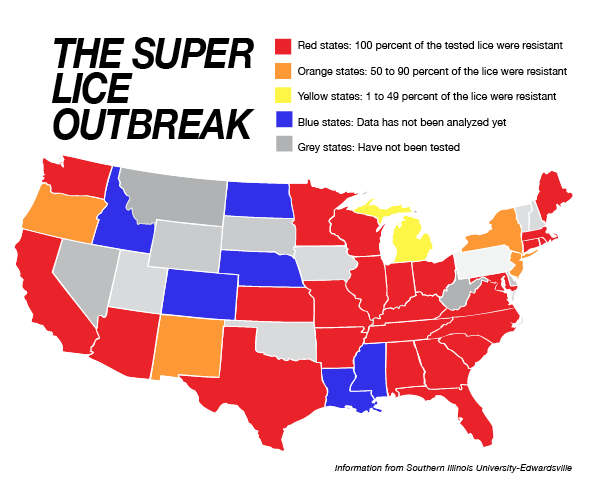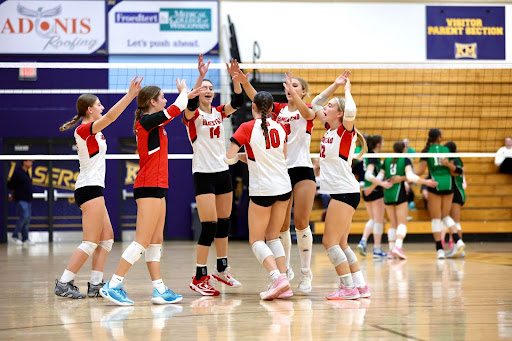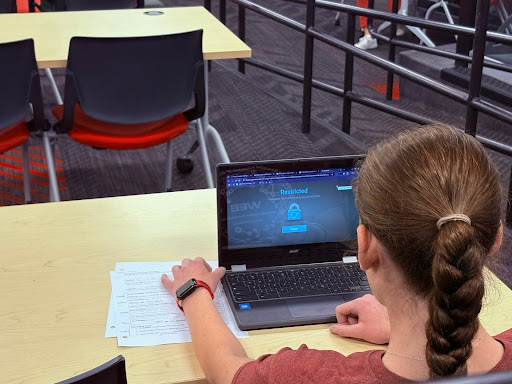Super lice crawls across 25 states

Infographic made by Molly Riebau
Super lice, a lice resistant to common over-the-counter treatments, has infected 25 states, including Wisconsin.
Super lice, a strain of lice with gene mutations, allowing them to be resistant to the common chemicals that kill them, has spread to 25 states, including Wisconsin. Lice and other insects, according to Kyong Yoon, an assistant professor at Southern Illinois University—Edwardsvillle, are becoming more resistant to pyrethroids.
Pyrethroids, the active chemical ingredients found in over-the-counter treatments, lock into the receptors in the lice’s nervous system, paralyzing and killing the bug. However, due to evolution of the species, the chemicals no longer fit in the receptors, eliminating the chemical capabilities of the current treatments.
Yoon, at the annual meeting of the American Chemical Society, which was held in August, reported, “We collected 109 lice populations and 104 had high levels of gene mutations.”
KSDK.com reported, “Pyrethroids used to work 100 percent of the time back in 2000, but by 2013, it only worked in 25 percent of cases.” While the over-the-counter treatments are becoming less effective, pyrethroids can still be used to kill the insects; however, a higher dose is needed to effectively eliminate the critters.
FDA-approved and developed by Lice Clinics of America, AirAlle, a new lice treatment, “kills head lice and 99.2 percent of lice eggs in a single, one-hour treatment,” according to AirAlle.com.
This treatment has been found to combat super lice through dehydration, a method differing from traditional treatments that aim to treat head lice with pesticides, suffocation or combs. “The device, which was invented by scientists at the University of Utah, kills lice and eggs through a specific combination of temperature, airflow, time and technique,” AirAlle.com read.
The AirAlle treatment costs $170 and, as reported by AirAlle.com, “[it] is so effective at killing lice eggs (which are the hardest for traditional lice products to kill), the chances of needing a follow-up treatment are very small.” Claire Roberts, CEO, Lice Clinics of America, said of the new treatment, “It takes about an hour, and we guarantee it.”
Pediatric dermatologist Dr. Robin Gehris still believes in the over-the-counter treatments, but in some cases, treatments do not do a thorough job because parents don’t use them as directed. Additionally, when using a treatment, it is crucial to apply it a second time five to seven days later, since some treatments don’t kill all the eggs the first time, and survivors of the first treatment will hatch within a week, Gehris said.
Gaby Geiger, senior, was sent home earlier this year under the suspicion that she had lice. She said, “Even though I didn’t have lice, I did several treatments, both over-the-counter and home remedies, and I put all of my clothes in garbage bags to suffocate the lice.” She continued, “It was really important for me to take every measure possible.”
Home remedies, due to the resistance the super lice have built, have been used widely to treat the super lice. However, Gehris said, “Olive oil, mayonnaise, Vaseline–these are all treatments I wouldn’t recommend. If you want to use mayonnaise as an adjunct, I’m okay with that. Theoretically, it could work if you put it on thickly enough that the lice aren’t able to breathe. But it’s hard to imagine that you could get it on thickly enough to really do the trick.”
According to Henry Ukpeh, a pediatrician in Trail, British Columbia, and todaysparent.com, the best defense against lice is to avoid head-to-head contact and sharing things like brushes or hats. He also suggests cutting kids’ hair shorter, or keeping long hair tied back in braids or ponytails, because lice move between people by crawling onto hair.
Once lice have been discovered, it is important to apply treatment as soon as possible and to avoid contact with other people. Katrina Puyleart, center director of Bright Beginnings in De Pere, Wisc., said, “When we have a child with a communicable illness, they are required to stay home for 24 hours symptom-free.”
Albeit the most drastic measure to defeat the bugs, completely shaving a lice-infested head may be the best option. Dr. Bernard Cohen, a professor of pediatrics and dermatology at the Johns Hopkins Children’s Center, suggested that the destruction of the lice’s habitat is a proven and 100 percent-effective way to treat the lice. Cohen said, “If you destroy an organism’s habitat, then they are dead meat.”

Molly Riebau is the Editor-in-Chief of The Highlander Newsmagazine. Aside from journalism, she loves watching The Bachelor (more than any...








